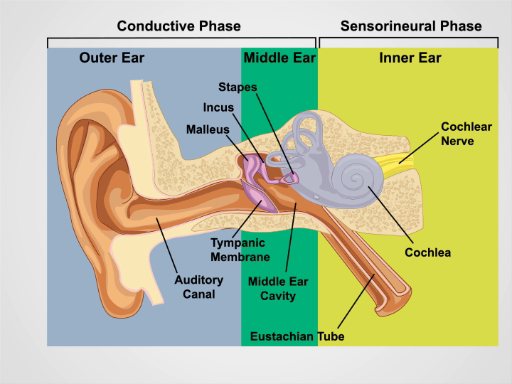귀 시험
Overview
출처: 리처드 글릭먼-사이먼, MD, 조교수, 공중 보건 및 지역 사회 의학학과, 터프츠 의과 대학, 석사
이 비디오는 표면 및 내부 해부학(그림 1)의검토로 시작하여 귀의 검사를 설명합니다. 카르티라기누스 오리클은 나선, 항헬릭스, 귓불, 트래구로 구성되어 있습니다. 마스토이드 과정은 귓불 바로 뒤에 위치합니다. 약간 구부러진 청각 운하는 외부 귀에 의해 수집된 음파를 공기로 채워진 중이로 전송하는 타일패닉 멤브레인에서 끝납니다. 유스타키아 튜브는 중이와 비소판과 연결됩니다. 고막의 진동은 중이의 세 개의 연결된 오시클(말루, 근간 및 스테이프)으로 전달됩니다. 진동은 내이의 전기 신호로 변환된 다음 달팽이관 신경에 의해 뇌로 운반됩니다. 따라서 청력은 외부 및 중이, 및 내이 및 달팽이관 신경을 수반하는 감각 신경성상을 포함하는 전도성 단계를 포함한다.
청각 운하와 타일파닉 멤브레인은 이강, 광원이 있는 휴대용 기기, 돋보기 및 일회용 콘 모양의 분광기로 검사됩니다. 타막 랜드 마크(그림 2)에익숙해지는 것이 중요합니다. 말루와 근친상부 등 3가지 오실 중 단 두 개만 볼 수 있습니다. 말루는 중앙 근처에 있으며, 커미티드는 단지 후방에 불과합니다. 빛의 원뿔은 움보에서 아래쪽으로 그리고 전방으로 발산되는 것을 볼 수 있습니다, 또는 막과 말의 끝 사이의 접촉 지점. 짧은 과정은 대략 타일플라닉 막의 두 영역 사이의 경계를 구분: 파스 flaccida,우수한 후후방 거짓말, 그리고 훨씬 더 큰 파 텐사,거짓말 전방및 열등. 일반적으로, 고막막은 분홍색 회색 색상이며 쉽게 이스코프의 빛을 반사합니다.

그림 1. 귀의 해부학. 외부, 중간 및 내이 구조가 표시된 정면 섹션에서 인간의 귀를 회로도 그립니다.
Procedure
1. 귀 시험 및 청력
- 피부 변화, 간절 및 기형에 대한 청각 및 주변 조직을 검사합니다.
- 엄지와 집게 손가락 사이에 우월하게 나선을 잡고 부드럽게 위로 뒤로 당겨 외부 귀의 어느 곳에서나 불편함을 확인합니다.
- 부드러움을 위해 트라구와 마스토이드 과정을 만파.
- 청각 시력에 대한 속삭이는 음성 테스트를 수행합니다.
- 방이 조용하다는 것을 확인하십시오.
- 앉은 환자 뒤에 2피트 를 서서 얼굴을 볼 수 없도록 하십시오.
- 테스트되지 않은 귀의 트래거스에 손가락을 부드럽게 누르고 문지르므로 다른 소리를 감지할 수 없습니다.
- 완전히 숨을 내쉬고 3 개의 숫자와 문자의 조합을 속삭입니다.
- 반대 귀에 대 한 다른 조합으로 프로세스를 복제 하기 전에 다시 그들을 반복 하는 환자를 요청 합니다. 3개의 숫자와 문자를 모두 올바르게 보고하는 것은 정상적인 테스트입니다. 환자가 실수를하면 그
Application and Summary
귀의 적절한 평가는 청력 검사 및 이토스코픽 시험이 필요합니다. 전도성 난청은 외부 및 중이의 장애로 인해 발생합니다. 세루멘 내막, 중이염 엑스테르나, 외상, 이물질 및 (덜 일반적으로) 외항은 청각 운하를 방해하여 청력 상실로 이어질 수 있습니다. 청력 감소의 중이 원인은 중이염 매체, 유스타키안 관 기능 장애, 바로 외상 및 이토경화증을 포함합니다. 신경 감각 난청은 내이의 장애때문?...
건너뛰기...
이 컬렉션의 비디오:

Now Playing
귀 시험
Physical Examinations II
54.6K Views

눈 검사
Physical Examinations II
76.7K Views

안과 검사
Physical Examinations II
67.4K Views

코, 부비동, 구강 및 인두 검사
Physical Examinations II
65.3K Views

갑상선 검사
Physical Examinations II
104.5K Views

림프절 시험
Physical Examinations II
385.6K Views

복부 시험 I: 검사 및 Auscultation
Physical Examinations II
202.2K Views

복부 시험 II: 타악기
Physical Examinations II
247.7K Views

복부 시험 III: 심포지엄
Physical Examinations II
138.3K Views

복부 시험 IV: 급성 복부 통증 평가
Physical Examinations II
67.1K Views

남성 직장 시험
Physical Examinations II
114.0K Views

종합 유방 시험
Physical Examinations II
87.0K Views

골반 시험 I: 외부 생식기의 평가
Physical Examinations II
305.1K Views

골반 시험 II: 스펙큘럼 시험
Physical Examinations II
149.8K Views

골반 시험 III: 양수동 및 교구 시험
Physical Examinations II
147.2K Views
Copyright © 2025 MyJoVE Corporation. 판권 소유